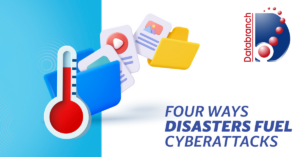
Your business, in all likelihood, already faces numerous challenges in today’s tech-driven world. However, the aftermath of an unexpected disaster can push your organization to its breaking point. This unintentionally creates opportunities for cybercriminals to launch devastating attacks, amplifying the chaos caused by such events.
Disaster preparedness should be a top priority for your business — not only for physical resilience but also for fortifying your digital defenses. By understanding how disasters fuel cyberattacks, you can proactively safeguard your business against these deceptive threats.
Understanding How Disasters Amplify Cyberthreats
Let’s look at four major ways disasters amplify cyberthreats and what strategies you can utilize to bolster your cybersecurity posture in the face of adversity.
1. Leveraging Diverted Attention and Resources
When a disaster strikes, the immediate focus shifts toward safety and recovery. Unfortunately, this diverts attention and resources away from maintaining and protecting your IT systems and networks.
With a reduced emphasis on cybersecurity measures, essential updates and monitoring may be overlooked, leaving your networks vulnerable to intrusion. Cybercriminals seize this opportunity to infiltrate your systems, compromise sensitive data and disrupt your operations.
To tackle this situation, establish a dedicated team responsible for monitoring and maintaining cybersecurity, even during times of crisis. For our managed clients, Databranch takes this one step further by implementing automated security systems to scan for vulnerabilities and apply necessary patches continuously.
By ensuring cybersecurity remains a priority, even in challenging times, you can minimize the risk of cyberattacks
2. Exploiting Fear, Urgency, Chaos and Uncertainty
Disasters create an environment of fear, urgency, chaos and uncertainty — prime conditions for cybercriminals to thrive in. They launch targeted attacks, such as deceptive emails or fraudulent websites, capitalizing on the sense of urgency and the need for quick solutions. By manipulating individuals into disclosing sensitive information, cybercriminals gain unauthorized access to critical systems. They could also sell this sensitive data on the dark web.
To combat this, educate your employees about the tactics used in phishing attacks and social engineering scams. Train them to recognize warning signs, such as suspicious emails or requests for sensitive information. Encourage a culture of skepticism and verification, where employees double-check the authenticity of requests before sharing confidential data.
By fostering a vigilant and informed workforce, you can fortify your defense against cybercriminals seeking to exploit fear and uncertainty. Visit us here to download our cybersecurity culture checklist.
3. Damaging Critical Infrastructure
Disasters can cause severe damage to your critical infrastructure, compromising components integral to your cybersecurity measures. Destruction of servers, routers or firewalls can weaken your defense mechanisms, allowing cybercriminals to exploit security gaps.
To address this challenge, ensure your critical infrastructure has backup and disaster recovery in place. Regularly back up your data, store it securely off-site or in the cloud, and test the restoration process to ensure it functions smoothly. Implement robust disaster recovery and business continuity plans, including provisions for cybersecurity.
By maintaining resilient infrastructure and regularly testing your backup and recovery processes, you can mitigate the impact of infrastructure damage on your cybersecurity.
4. Impersonation and Deception
In the wake of a disaster, cybercriminals often exploit the trust associated with relief organizations and government agencies. By impersonating these trusted sources, they deceive victims through phishing emails, messages or calls, tricking them into divulging sensitive information or engaging in fraudulent transactions.
To protect yourself from such scams:
- Encourage your employees to verify the authenticity of any communication received during a disaster.
- Advise them to independently contact the organization or agency through known, trusted channels to confirm the legitimacy of any requests.
- Establish robust security awareness training programs that educate employees about common impersonation tactics and teach them how to report them effectively.
By promoting a culture of caution and verification, you can defend against impersonation and deception tactics used by cybercriminals. Our phishing infographic is a great educational resource that can be shared with your workforce to prepare them for real life threats.
Act Now to Safeguard Your Business
Now that we know how cybercriminals can target your business during a disaster, prioritizing disaster preparedness and implementing the above-highlighted measures are important to navigate today’s ever-evolving technology landscape.
If you need expert guidance, Databranch is here to help fortify your disaster preparedness and cybersecurity efforts. Together, let’s ensure a resilient and secure future for your business. Contact us today at 716-373-4467 x6 or [email protected] to proactively safeguard what you’ve worked so hard to build.
Read More

A disaster preparedness plan helps businesses withstand any calamity. However, many businesses are unaware that a cybersecurity strategy is also crucial for building a robust disaster preparedness plan.
By incorporating cybersecurity into your emergency preparedness plan, you can better protect your business during critical incidents and minimize the impact of cyberthreats. This will help you enhance your business’s resilience, ensuring you’re better equipped to function in the face of unexpected challenges.
Best Practices for Effective Disaster Preparedness Planning in IT Security
Here are some practical tips for improving your organization’s disaster preparedness planning:
1. Protect Your IT infrastructure and Data
Your data is a gold mine for cybercriminals, and they’ll do anything to get their hands on it. That’s why it’s important to strengthen your IT infrastructure to withstand any disaster. Failing to implement adequate measures to protect your data could also attract fines and lawsuits.
Pro tip
- Firewalls, intrusion detection systems and encryptions can strengthen your IT security.
- Implementing a process to fix and update software patches regularly will help you avoid security vulnerabilities.
2. Back up Critical Data
Data loss can occur for many reasons, including cyberattacks and natural disasters. If your organization has not correctly backed up its data, recovery can be costly, time-consuming and seemingly impossible. Visit Databranch here to utilize out Recovery Time Calculator and see just how costly a disaster can be for your company.
If you want your business to survive, your disaster preparedness plan must ensure that your data remains clean, available and restorable.
Pro tip
- Regularly back up critical data.
- Back up your data off-site or in the cloud.
- Test backups regularly to verify their integrity.
Here at Databranch, our disaster recovery solution not only ensures that your data is restored to its former state, but restored quickly, with little to no downtime or interruption to your business.
3. Improve Employee Awareness
Your employees are your weakest link only if they don’t have proper training. By conducting regular security awareness training, you can improve their knowledge. It also increases your employees’ ability and willingness to follow security protocols during an emergency.
Pro tip
- Train your employees to identify phishing attempts, report suspicious activities and follow security protocols.
- Promote a culture of preparedness.
- Routinely test employee preparedness through simulated scenarios or drills.
Databranch offers ongoing and interactive training to help you stay secure and keep up with cybercriminals and their ever-changing tactics. Our Breach Prevention Platform and Security Awareness Training will give your employees the resources they need to spot real world phishing attempts.
4. Review Insurance Policies
Insurance plays a critical role in promoting disaster resilience and can help speed up your recovery after an incident. It’s a good idea to have property insurance, business interruption insurance, and cybersecurity insurance to cover all bases.
Pro tip
- Routinely review insurance policies to ensure you have proper coverage for potential risks and disasters.
- Maintain records of your assets, inventory and financial transactions to facilitate insurance claims and recovery efforts.
- Take the help of an insurance expert to understand current coverage and determine if additional coverage is required.
5. Evaluate Vendor and Supplier Preparedness
Disasters come unannounced and any weak link in your supply chain will only increase your vulnerability. Knowing if your vendor has a disaster preparedness plan is crucial for protecting your customers and overall business operations.
Pro tip
- Ensure your vendors’ or suppliers’ disaster preparedness practices align with your plans.
- Ask your vendor to share their disaster communication plan with you.
- Recommend that your suppliers test their disaster plan at least once a year.
- Guide them to an experienced service provider such as Databranch if they express needing assistance
6. Review and Revise Your Preparedness Strategies
It’s essential to test your preparedness plan for weaknesses and shortcomings regularly. By testing, you can fix the gaps and strengthen your strategy. A thoroughly tested plan will protect your data and help you avoid revenue loss during an outage, cyberattack or natural disaster.
Pro tip
- Extensively document changes in the organization, including people, processes and resources.
- Conduct mock tests to gauge the preparedness of your plan and employees.
- Take the help of an IT service provider to enhance your plan. They can also carry out timely audits to test the effectiveness of your program.
Databranch Can Help You Outlast Disasters
It can be challenging to build a comprehensive disaster preparedness plan that is robust and includes a thorough cybersecurity strategy on your own. By partnering with Databranch, your business can become resilient and outlast any disaster.
Contact us today at 716-373-4467 x6 or [email protected] to see how we can help your business build a solid disaster preparedness plan. You can also download our disaster preparedness eBook by filling out the form below.
Read More

Databranch has been notified about a new Microsoft support scam that is generated after users click on a false Amazon ad.
Clicking on this sponsored Google ad will redirect users to a Microsoft technical support scam. This scam will claim to be Windows Defender, stating that your device has been infected with malware.
Why is this Noteworthy:
Google search engine is widely used by consumers worldwide. Users often click the top results, which are ‘Sponsored’ results. Currently, those who are searching for Amazon are at risk of being a victim by scammers.
A similar scam was seen last year through YouTube ads where it displays a website’s legitimate URL but leads to the scam website.
This presents a major security concern as scammers who gain access to a computer can not only install malware, but can also steal personal and financial information.
Recommendations:
- Avoid clicking on Amazon sponsored Google ads
- Visit website by their Fully Qualified Domain Name (FQDN)
Please feel free to reach out to [email protected] with any questions.
If you are not a managed client and would like to discuss how Databranch can help to proactively manage, monitor, and patch your IT environment, please reach out to Databranch at 716-373-4467 option 6 or [email protected].
Read More











